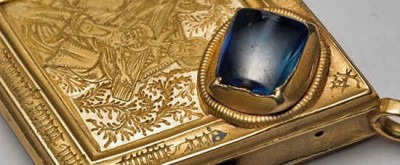Middleham Jewel

The Middleham Jewel
© Yorkshire Museum
Associated people
Associated places
Description
The Middleham Jewel was found in September 1985 by Mr Ted Seaton. In 1991 it was bought by the Yorkshire Museum. Other items of jewellery found in the area include a copper alloy boar badge in 1930, which could have been a gift to a retainer of Richard III, like the boar badges distributed when he visited York after his coronation, and the Middleham Ring in 1990. Link to Pageants and Spectacle article The jewel has a large sapphire on the front, along with a Latin inscription and an engraving of the Trinity. Sapphires were believed to have a variety of properties in the late-medieval period, such as protecting the body from illness, encouraging peace and chastity and inclining God to listen favourably to prayers, and were often set in royal and episcopal rings. Precious stones were also sometimes thought to aid childbirth; the blue of the sapphire is also the colour of the Virgin Mary. Part of the inscription reads ‘Behold the Lamb of God who takes away the sins of the world, have mercy on us.’, which was a common recitation by the priest in mass. The other part reads ‘Tetragrammaton ananizapta’, with ‘Tetragrammaton’ being the Greek translation of the Hebrew for God and ‘ananizapta’ being believed to be a magical word used against drunkenness or epilepsy. The back of the frame shows fifteen saints around a Lamb of God above a Nativity scene. The jewel probably dates from the third quarter of the fifteenth century and it is likely to have belonged to a lady, as there is evidence of noble ladies wearing lozenge-shaped pendants, such as images of Eleanor, daughter of Richard Beauchamp, Earl of Warwick, and Isabel, daughter of Richard Neville, wearing lozenge-shaped jewels on their necklaces. Possible owners of the jewel which have been suggested are Anne Beauchamp, Countess of Warwick and Richard III’s mother-in-law, Cecily Neville, Richard III’s mother, and Anne Neville, Richard III’s wife, as they all spent time at Middleham.
When it was discovered the jewel contained 3.5 small roundels of silk embroidered with golden thread and manufactured in England, which may have come from a bishop’s cope, soil and roots, although it is unlikely that these were the original contents. The jewel appears to have been a reliquary, which is a container for holy relics, and shows signs of having been opened regularly. Reliquaries were popular in the medieval period as a means of demonstrating conspicuous piety. It has been suggested that the jewel was originally intended to hold an agnus dei (medallion stamped with the Lamb of God and banner of Resurrection). These were given out by the papacy on Easter Sunday from the twelfth century. They increased in number in the fourteenth century and there was an illicit trade in fakes in the fifteenth-century, with at least three moulds existing in England. Agnes dei were often worn by pregnant women. There are many references to agnes dei and noblewomen in fifteenth and sixteenth-century sources, which supports the idea that the jewel belonged to a noblewoman who visited Middleham.
Some of the saints on the jewel have been identified due to the appearance of iconography connected to each saint, but others remain anonymous. St Peter, the first Pontiff of Rome, appears along with St Paul, who wrote a series of famous epistles. St George, the patron saint of England, has been firmly identified as one of the male saints. There are also female saints depicted in the border of the jewel. St Barbara, an early martyr who was believed in the fifteenth century to ensure that her devotees did not die without receiving the sacrament, appears along with St Margaret of Antioch, the patron saint of pregnancy and childbirth. St Catherine of Alexandria, patron saint of many things including girls and the dying, St Dorothy, a virgin martyr who converted the pagan lawyer Theophilus on the way to her execution, and St Anne, the mother of the Virgin Mary and patron saint of women in labour and grandmothers amongst others, are the other identified female saints on the jewel.
The identities of two other male saints on the jewel are more ambiguous, but four names have been put forward by those studying the jewel as possible contenders to be these two saints. St Augustine of Hippo, who is most well-known for writing the City of God has been suggested, along with St Nicholas, the fourth-century Bishop of Myra, in modern-day Turkey. St Jerome, who translated the Bible into Latin and St Anthony, the first Franciscan Lector of Theology were also suggested as possible identities for these saints.
There are five more anonymous saints in the border of the jewel. One of the saints on the bottom of the left side, a female with uncovered hair (so therefore likely to be unmarried), appears to have been particularly important to the commissioner of the jewel as she is larger than the other saints. It has been suggested that this saint could be St Agnes, the patron saint of unmarried girls, St Lucy, the patron saint of the blind, or St Cecilia, the patron saint of musicians. The other unidentified saint on the bottom of the left side appears to be a female with tied-up hair who holds the martyr’s palm. There is an unidentified mature female saint with covered hair in the bottom of the right side, who could be St Clare, founder of the Order of Poor Ladies. However, this saint could also be St Helen, the mother of Constantine the Great and finder of the True Cross, or St Bridget of Sweden, who claimed to have had a vision of the Nativity in Jerusalem. The depiction of the Nativity on the jewel is in the style of Bridget’s vision, which became one of the most common depictions of the scene in the fifteenth century. The other two unidentified saints on the bottom of the right side are a bearded male with the martyr’s palm, who is holding an unidentified object in his right hand, and a bearded male saint who is chopped off at the knees.

